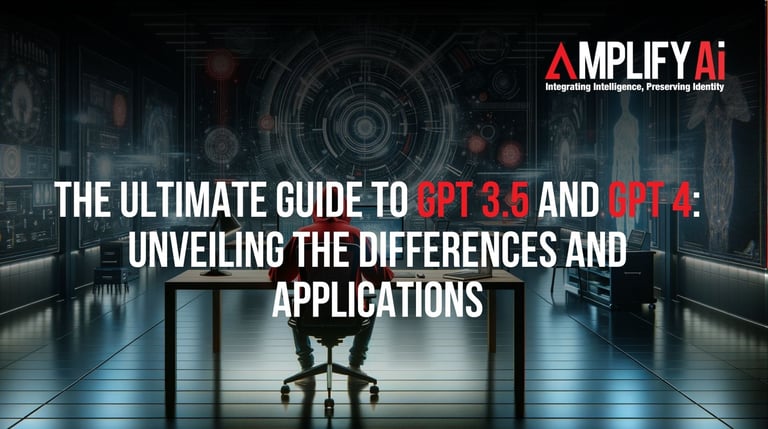The Ultimate Guide to GPT 3.5 and GPT 4: Unveiling the Differences and Applications
Ronsley Vaz
4 min read


In the ever-evolving landscape of artificial intelligence, two language models have captured the attention of business owners, entrepreneurs, and tech enthusiasts alike: GPT 3.5 and GPT 4. Developed by OpenAI, these models have opened new doors for AI-driven applications and interactions. In this comprehensive guide, we'll explore the key differences between GPT 3.5 and GPT 4, as well as their diverse applications that hold the potential to reshape industries and redefine user experiences.
GPT-4 is larger and can store more information than GPT 3.5, but requires more resources to operate effectively. Despite this, GPT-4's longer training time and higher resource consumption are balanced by its capacity to handle more complex tasks.
A Journey into the World of GPT 3.5 and GPT 4
Imagine a seasoned computer expert with 31 years of experience stepping into the realm of entrepreneurship and artificial intelligence. This intriguing combination serves as the backdrop for our exploration. Let me introduce you to GPT 3.5 and GPT 4 in a captivating podcast episode. Drawing parallels between the versions of a video game, I simplify the concept of model updates, emphasizing how each new iteration brings enhancements, new features, and unique challenges.
GPT-4 is larger than GPT 3.5 and can store more information, but requires more resources to operate effectively. Additionally, GPT 4's training on more recent and diverse data enhances its performance, making it capable of more complex tasks than GPT 3.5.
Applications: Unleashing the Power for Businesses
One of the most exciting things we discussed in the episode was the practical applications of GPT 3.5 and GPT 4. These models are more than just technological marvels - they have the potential to revolutionize various industries. For example, in customer service, GPT-4 could provide more accurate and helpful responses due to its larger size and capacity. In content creation, GPT-4 might generate more creative and diverse content because of its larger "brain" (more parameters). And in language translation, GPT-4 might do a better job because it has been trained on more recent and diverse data. These are just a few examples of how these models can be applied. It's exciting to think about the possibilities and how they can help businesses and industries be more efficient, effective, and innovative.
Customer Service Automation: GPT 4 emerges as a potential game-changer for customer service automation. Its larger size and capacity allow for more accurate responses, enriching customer interactions and streamlining support processes.
Content Creation: The episode sheds light on GPT 4's capability to generate creative and diverse content. With a larger brain akin to more parameters, GPT 4's potential for crafting engaging articles, blogs, and marketing materials becomes evident.
Language Translation: Both models possess language translation prowess, yet GPT 4's advantage lies in its exposure to more recent and diverse data. This positions it as a reliable tool for breaking language barriers and fostering global communication.
Demystifying Model Differences
The differences between GPT 3.5 and GPT 4, both being language models developed by OpenAI for various applications. GPT-4 is a larger model that can store more information but requires more resources to operate effectively. It is trained on more recent and diverse data, which enhances its performance and makes it capable of more complex tasks than GPT 3.5. The models have different training times and resource consumption, which should be taken into account when choosing which model to use for a particular task.
The episode stresses the importance of evaluating the specific needs of a business or project before choosing which AI model to use. It is essential to understand the strengths and weaknesses of each model and match them to the requirements of the task at hand.
Here are the core differentiators that distinguish these AI powerhouses:
Model Size and Capacity: GPT 4's larger size allows it to store more information, enabling more complex tasks. However, this increased capacity demands greater computational resources for optimal performance.
Training Data and Performance: GPT 4's training on recent and diverse data empowers it with enhanced performance, making it adept at tackling intricate tasks that GPT 3.5 might struggle with.
Components: Tokens and Parameters: Tokens, akin to words in a sentence, and parameters, the model's brain cells, collectively shape the models' capabilities. GPT 4's higher token limit and parameters contribute to its expanded abilities.
Training Time and Resource Consumption: GPT 4's extended training time and resource consumption are counterbalanced by its proficiency in handling intricate tasks, making it a formidable choice for complex AI applications.
Implications for Businesses: Making the Right Choice
Think about it. If you were setting up a delivery service in a busy city, would you choose a sports car? Probably not. Just like in business, understanding the specific needs and choosing the right AI model is crucial.
So, what if you're a budding entrepreneur or a well-established business owner? How do you navigate this? Do you find yourself asking, "Which model aligns with my business objectives?"
GPT 4's creative content generation shines, while GPT 3.5 excels in producing human-like responses. The analogy of selecting a car engine that suits your needs resonates—opt for GPT 4's robust performance when tackling complex tasks, while GPT 3.5 is your go-to for human-like text responses.
Unlocking Potential: The Road Ahead
The AI journey, much like our own personal and professional journeys, is filled with choices. It's a dance between embracing innovation and respecting foundational tools. The real magic? It's not just in the choice but understanding why we make that choice.
To all the businesses, entrepreneurs, and curious minds out there: As we stand on the cusp of unparalleled technological advancements, the question isn’t just “Which model?” but rather, “What’s the story we want to write with it?”
Final Thoughts: The Symphony of Choice
In the grand symphony of technological progress, GPT-3.5 and GPT-4 are but two notes. Distinct, powerful, and resonating differently with each listener. As the maestros of our ventures, the baton is in our hands. How will you lead your orchestra?
GPT 3.5 and GPT 4 stand as testaments to the rapid advancements in AI technology. This podcast episode masterfully navigates through the complexities of these models, translating technical nuances into relatable insights. As industries evolve and businesses seek innovative solutions, understanding the differences and applications of GPT 3.5 and GPT 4 becomes pivotal. This ultimate guide provides a comprehensive roadmap for leveraging these language models' potential and propelling businesses into the era of AI-powered excellence.
Subscribe to the podcast
Subscribe now to "Amplify Ai" and let's set sail together on this exciting voyage towards business growth and success.



